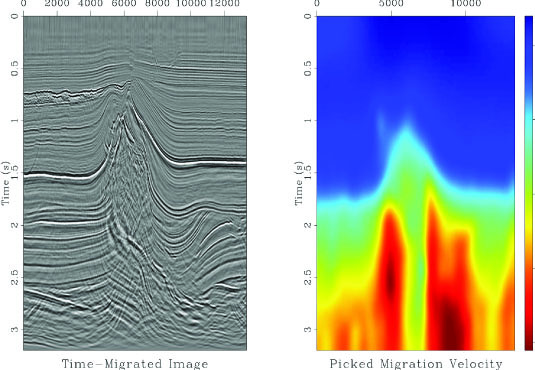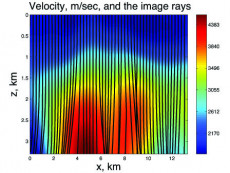Seismic imaging: Reconstruction of the earth from surface recordings
In order to reconstruct seismic velocities from reflected wave surface recordings, common seismic imaging “time-migration” techniques assume horizontal layers. With even mild lateral velocity variations, this significantly distorts subsurface structures. They also produce images in “time migration coordinates”, which gives velocities at points reached by rays from the Earth’s surface at a given time. For laterally varying velocities, the relation between this somewhat unnatural coordinate system and the more appealing Cartesian coordinates can be nontrivial. In contrast, for lateral velocity variations, depth migration effectively produces seismic images in Cartesian coordinates, however its input requires a “velocity model” for the seismic velocity at the underground points. Constructing an adequate velocity model is difficult and time-consuming; instead, one often uses an iterative approach of guesswork followed by correction. We have been able to build fast and robust algorithms to (i) convert time migrated coordinates to depth coordinates and (ii) convert migration velocities to depth velocities. These algorithms allowed imaging of subsurface substructures 3.3 km deep in a North Sea salt dome example with severe lateral variations.

About Berkeley Lab
Founded in 1931 on the belief that the biggest scientific challenges are best addressed by teams, Lawrence Berkeley National Laboratory and its scientists have been recognized with 16 Nobel Prizes. Today, Berkeley Lab researchers develop sustainable energy and environmental solutions, create useful new materials, advance the frontiers of computing, and probe the mysteries of life, matter, and the universe. Scientists from around the world rely on the Lab’s facilities for their own discovery science. Berkeley Lab is a multiprogram national laboratory, managed by the University of California for the U.S. Department of Energy’s Office of Science.
DOE’s Office of Science is the single largest supporter of basic research in the physical sciences in the United States, and is working to address some of the most pressing challenges of our time. For more information, please visit energy.gov/science.










